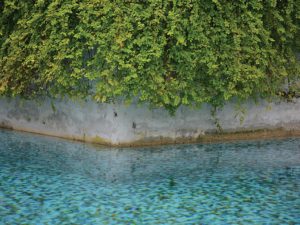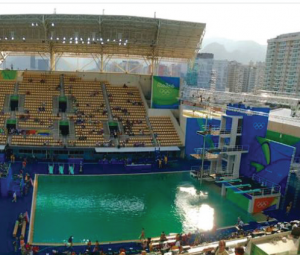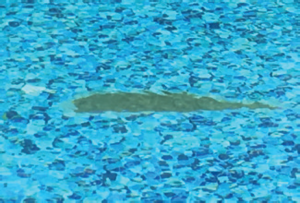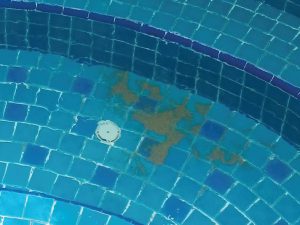Poor Water Quality

Traces of dirt and algae growth at the tile rim of planter due to close proximity of plant landscape to the pool

Algae growth turns the pool green and swampy [1]

Soil and green patches from the damaged pool flooring

Sand accumulates on the pool’s surface
Design Guidelines
- Provision of accurate and reliable testing kit(s) (to measure the pool water’s pH level, as well as to check for free residual chlorine, total available chlorine, bromine or other chemical disinfectant residuals, cyanuric acid (if used), total alkalinity, calcium hardness, and copper and silver. Daily records must be maintained (ISO 17381:2003).
- The pool must be so designed that the water quality will always remain safe for the public during its operation [2]. Refer also to BS EN 16713-1: 2016; BS EN 16713-2: 2016; BS EN 16713-3: 2016 and AS/NZ 1926.3-2010.
- Ensure that pool design specifications require the maintenance of the pool water at a pH value between 7.2 and 7.8 [2].
Construction Guidelines
- Do not plant landscape and trees too close to pool, to prevent overflow of water from the planting strip(s) that may contaminate the water in the pool and also create maintenance problems [2].
- The choice of material for pool furniture should withstand dampness and exposures to UV light. Ensure that during and after construction, there are no depressions in the concourse which will result in water pooling and/or lead to microorganism growth [3, 4].
- Installation of the water treatment system should conform as per SS 556:2010. Refer also to BS EN 16713-1:2016; BS EN 16713-2:2016; BS EN 16713-3:2016 and AS/NZ 1926.3- 2010.
Maintenance Guidelines
- Use adequate level of a chemical in water to destroy micro-organisms (e.g. chlorine). Reduce chloramines in water using ozone, UV light irradiation, or addition of non-chlorine oxidising chemicals. (SS 556:2010). (See also BS EN 16713-3:2016 and AS/NZ 1926.3-2010).
- Conduct monthly bacteriological sampling and constantly check that the disinfectant level and pH value are correct, to ensure the bacteriological quality of a well-run pool [4].
- Water quality testing should be conducted by an accredited laboratory at least monthly for physico-chemical parameters (SS 556:2010, BS EN 16713-3:2016).
- Tests for microbiological analysis should also be carried out (ISO 19458:2006).
References
[1] Photo by Tom Daley taken from Menezes, J. D. (2016). Rio 2016: Green Olympic pool drained as organisers reveal hydrogen peroxide caused colour change. Retrieved on June 1, 2017 from http://www.independent.co.uk/sport/ olympics/rio-2016-greenb3067_pool-drained-as-olympic-organisers-reveal-hydro gen-peroxide-is-cause-of-colourchange-a7189616.html.
[2] National Environment Agency (2005). Code of Practice on Environmental Health. Singapore: National Environment Agency (NEA).
[3] Alliance for Water Efficiency (2017). Swimming Pool and Spa Introduction. Retrieved on March 22 from http://www.allianceforwaterefficiency.org/Swimming _Pool_and_Spa_ Introduction.aspx.
[4] Health and Safety Executive (2003). HSG179: Managing health and safety in swimming pools (3rd ed.). England: HSE Books and Sport England Publications.
Normative References/Standards Referred to for Common Area
• AS/NZ 1926.3-2010 — Swimming pool safety — Part 3: Water recirculation systems
• BS EN 16713-1:2016 — Domestic swimming pools. Water systems. Filtration systems. Requirements and test methods
• BS EN 16713-2:2016 — Domestic swimming pools. Water systems. Circulation systems. Requirements and test methods
• BS EN 16713-3:2016 — Domestic swimming pools. Water systems. Water treatment. Requirements
• ISO 17381:2003 — Water quality — Selection and application of ready-to-use test kit methods in water analysis
• ISO 19458:2006 — Water quality — Sampling for microbiological analysis
• SS 556:2010 — Code of practice for the design and management of aquatic facilities